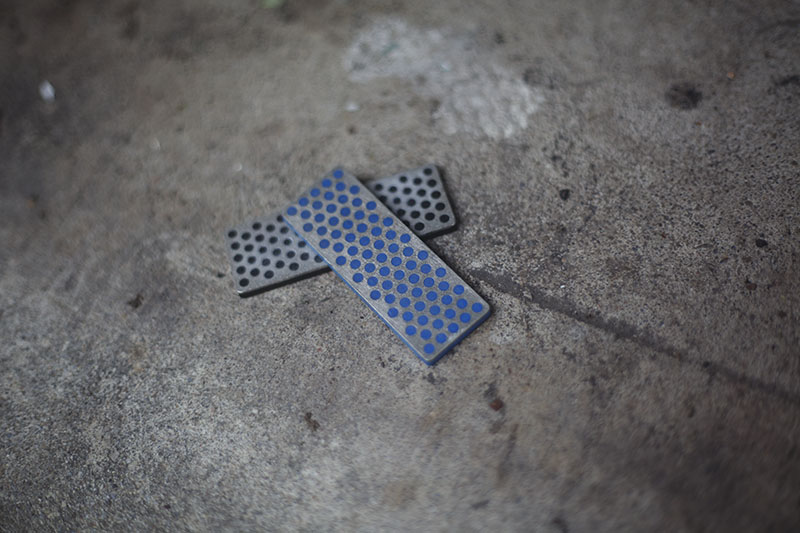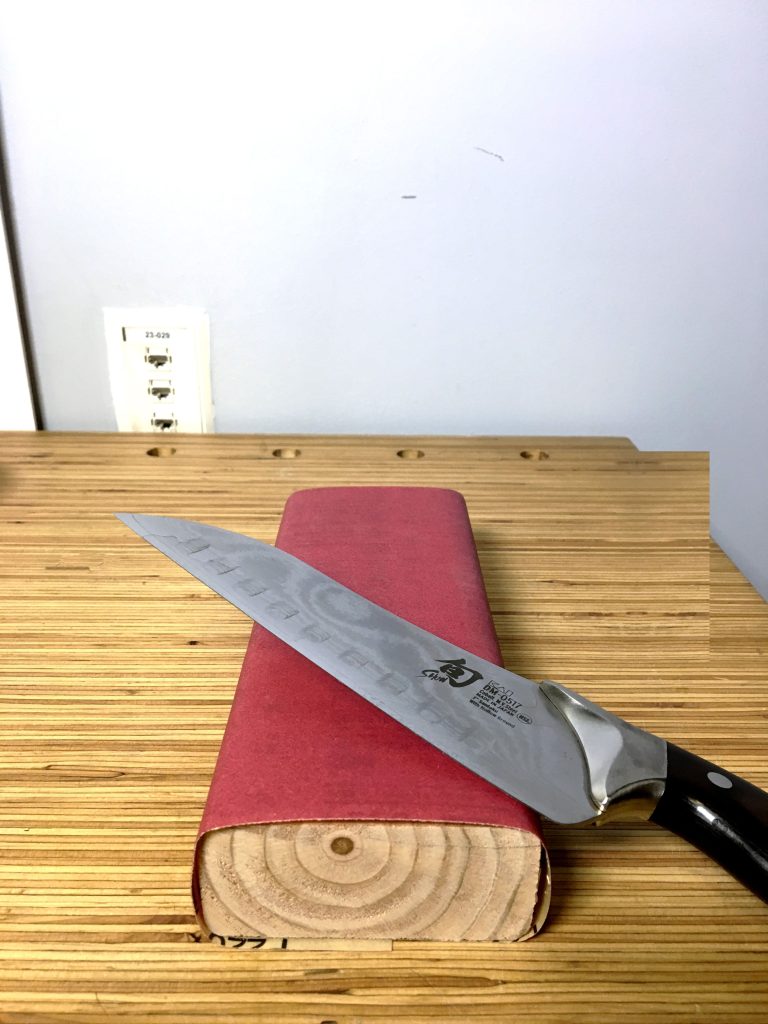You know the frustration of trying to slice through a ripe tomato only to end up with a mangled mess? Your stainless steel knife, once your trusty kitchen ally, now feels more like a dull butter knife.
Don’t worry—you’re not alone. Many home cooks face this challenge, and the good news is that you can restore your knife’s sharpness right from the comfort of your kitchen. Imagine effortlessly slicing through meats, vegetables, and fruits with precision and ease.
In this guide, you’ll discover simple, effective techniques to sharpen your stainless steel knives at home, ensuring every meal preparation is smooth and satisfying. Get ready to transform your cooking experience and make those dull blades a thing of the past.

Credit: www.amazon.com
Choosing The Right Tools
Choosing the right tools for sharpening stainless steel knives is crucial. Not every tool fits every knife. Selecting the right equipment ensures precision and safety. It also enhances the longevity of your knives. Let’s delve into two key aspects: types of sharpeners and selecting a sharpening stone.
Types Of Sharpeners
There are various sharpeners available. Electric sharpeners offer speed and ease. They are ideal for those short on time. Manual sharpeners require more effort but provide control. They suit those who prefer hands-on sharpening. There are also sharpening systems combining different methods. These systems offer versatility for different knife types.
Selecting A Sharpening Stone
Sharpening stones come in different materials. Diamond stones are durable and effective. They sharpen quickly and maintain their quality. Ceramic stones provide a smooth finish. They are gentle on delicate blades. Water stones require soaking before use. They offer precise sharpening for finer edges. Choose a stone based on your knife’s needs and your experience level.

Credit: morethanjustsurviving.com
Preparing Your Knife
Sharpening stainless steel knives at home ensures a clean and precise cut every time. Use a whetstone to maintain the blade’s edge. Follow simple steps to achieve optimal sharpness, enhancing kitchen efficiency and safety. Regular care keeps your knives in top condition.
Preparing your knife is the first step in sharpening it effectively. Proper preparation ensures a smooth sharpening process and prolongs the blade’s life. Let’s explore the two essential steps in preparing your knife.Cleaning The Blade
Start by cleaning your knife thoroughly. Use warm water and mild soap. Gently scrub the blade with a soft sponge to remove dirt and residue. This prevents any debris from affecting the sharpening process. Rinse the blade well and dry it with a clean cloth. Ensure no moisture remains to prevent rust.Assessing Sharpness
Check the sharpness of your knife before sharpening. Carefully run your thumb across the blade’s edge. Feel for any nicks or dull spots. Avoid running your finger along the edge to prevent cuts. Alternatively, use a piece of paper. Try slicing through it with the knife. A sharp knife will cut smoothly without tearing. If the knife struggles, it needs sharpening. Assessing sharpness helps you understand how much sharpening is necessary.Sharpening Techniques
Sharpening stainless steel knives at home can be simple with the right tools. Use a whetstone or sharpening steel for best results. Regular maintenance ensures knives stay sharp and efficient for everyday use.
Sharpening your stainless steel knives at home can transform your cooking experience. Dull knives can be dangerous and frustrating, but you don’t always have to rush to a professional to get them sharpened. You can achieve razor-sharp precision with a few simple techniques, making meal prep both safer and more enjoyable. So, grab your favorite knife and let’s dive into the world of home sharpening. ###Setting The Angle
One of the most crucial aspects of sharpening is setting the right angle. A common mistake is to underestimate its importance. The angle determines how sharp and durable your blade will be. For most stainless steel knives, a 15 to 20-degree angle works best. If you’re unsure, check the manufacturer’s recommendations. To find the right angle, imagine slicing a thin slice of cheese. That’s roughly the angle you need. You can also use an angle guide tool to help maintain consistency. ###Using A Whetstone
A whetstone is a popular tool for sharpening knives at home. It might seem intimidating at first, but it’s quite straightforward with practice. Start by soaking the whetstone in water for about 5 to 10 minutes. This ensures it’s ready for use. Place the whetstone on a flat surface, ensuring it’s stable. Hold the knife at your chosen angle, and gently slide it across the stone. Use a consistent motion, moving from the base of the blade to the tip. Alternate sides to ensure even sharpening. If you’ve never used a whetstone before, consider practicing on an old knife. This gives you confidence and helps you master the technique. Have you ever felt the satisfaction of slicing through a tomato effortlessly with a freshly sharpened knife? It’s a small joy that can make cooking so much more rewarding. So, take the time to learn these techniques, and your stainless steel knives will thank you.Finishing Touches
Sharpen stainless steel knives at home with ease using a whetstone or honing rod. Gently glide the blade over the tool, maintaining a consistent angle. Regular sharpening ensures clean cuts and prolongs the knife’s life.
Sharpening your stainless steel knives is not the last step. The finishing touches ensure your knives perform at their best. After sharpening, it’s essential to refine the edge and test its sharpness. These steps guarantee your knives are ready for any culinary challenge.Polishing The Edge
Polishing the edge removes any burrs left from sharpening. Use a leather strop or a honing rod for this. Gently slide the knife along the strop at the same angle used for sharpening. This process smooths the edge, enhancing its sharpness. It also adds a fine polish, making the knife look pristine. A well-polished edge reduces friction during cutting. This makes slicing smoother and more efficient.Testing Sharpness
Testing the sharpness is crucial before storing the knife. Use a piece of paper for a simple test. Hold the paper in one hand and slice it with the knife. The knife should cut through easily without tearing the paper. This test quickly shows if the knife is sharp enough. Another method is the tomato test. Try slicing a tomato with minimal pressure. A sharp knife will glide through effortlessly. Testing ensures the knife is ready for daily use. It also helps maintain safety in the kitchen.Maintenance Tips
Maintaining stainless steel knives at home extends their lifespan. Dull blades affect your cooking experience. Proper care ensures they remain sharp and efficient. Regular maintenance is key to keeping knives in top condition. Learn how to store and maintain them effectively.
Proper Storage
Store knives in a dedicated knife block. This prevents accidental damage. Use blade guards for extra protection. Avoid storing knives loosely in drawers. They can become dull or damaged. Magnetic strips are also a great option. Ensure they are mounted securely on the wall. This keeps knives organized and easily accessible.
Regular Maintenance
Sharpen knives regularly to maintain their edge. Use a whetstone or knife sharpener. These tools are effective and easy to use. Clean knives immediately after use. This prevents rust and stains. Dry them thoroughly before storage. Moisture leads to corrosion over time. Inspect knives for damage periodically. Replace or repair damaged ones promptly.
Common Mistakes To Avoid
Sharpening stainless steel knives at home can enhance their performance. But many make common mistakes, which can damage the blade. Understanding these errors is crucial. It helps keep your knives sharp and in good condition. Let’s explore some frequent mistakes to avoid.
Over-sharpening
Over-sharpening is a common error. It wears down the knife edge. You might think more sharpening equals a sharper blade. But it can actually damage the knife. Excessive sharpening removes too much material. It reduces the life of the blade. Always sharpen only when necessary. Listen to your knife. If it cuts well, it doesn’t need sharpening.
Incorrect Angle
The sharpening angle is vital. Many fail to maintain the correct angle. This can lead to a dull edge. Each knife has an ideal sharpening angle. Usually, it’s between 15 to 20 degrees. Use a guide or angle tool for help. Consistent angle ensures better sharpness. It also increases the knife’s lifespan.

Credit: morethanjustsurviving.com
Frequently Asked Questions
Can Stainless Steel Knife Blades Be Sharpened?
Yes, stainless steel knife blades can be sharpened. Use a whetstone or sharpening tool for best results. Regular maintenance keeps blades sharp and efficient. Avoid using electric sharpeners, as they may damage the blade. Proper sharpening techniques ensure longevity and performance of your stainless steel knives.
What Is The Best Knife Sharpener For Stainless Steel Knives?
The Chef’sChoice Trizor XV EdgeSelect is ideal for stainless steel knives. It offers precise sharpening with diamond abrasives. Electric sharpeners like this ensure efficiency and consistency. Manual sharpeners such as the Wüsthof Precision Edge can also work well, providing control and ease for stainless steel blades.
Can You Ruin A Knife With A Whetstone?
Yes, improper use of a whetstone can damage a knife. Using incorrect angles or excessive pressure can lead to uneven edges or scratches. Regular practice and correct technique ensure safe sharpening. Always follow recommended guidelines for your specific knife type to maintain its quality.
What Is The Best Home Method For Sharpening Knives?
Use a whetstone for sharpening knives at home. Soak it in water, then slide the blade across at a 20-degree angle. Repeat until sharp. Finish with a honing rod to maintain edge precision.
Conclusion
Sharpening stainless steel knives at home is simple and rewarding. With the right tools, you can maintain sharp edges. Remember, practice makes perfect. Start slow and steady. Use a whetstone or honing rod for best results. Keep knives clean and dry after sharpening.
Safety is key; handle blades carefully. Regular maintenance extends your knife’s lifespan. Enjoy a smooth cutting experience every time. Happy cooking and safe slicing!


